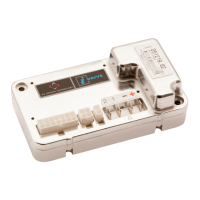PG DRIVES TECHNOLOGY I-DRIVE TECHNICAL MANUAL – INSTALLATION
3.5 Battery Connection
The i-Drive incorporates sophisticated current limiting circuitry as protection for the components inside the controller.
However, it is recommended that you provide protection against short circuits in the battery wiring and power loom or in the
extremely unlikely event of a short circuit in the controller.
It is recommended that the high current wiring to the i-Drive be kept as short as possible.
The machine manufacturer must install a suitable circuit breaker to provide protection against
short circuits in the battery wiring, power loom or the controller. Failure to comply with this
condition could result in a fire hazard. PGDT accepts no liability for losses of any kind arising
from failure to comply with this condition.
Applications that use an external line contactor to isolate the battery supply at ‘key-off’, may
require an additional ‘pre-charge’ resistor to be connected across the contacts. Please call PGDT
if you require further advice.
3.6 Motor Connection
If a circuit breaker is fitted in series with the motor, it is essential that the machine assumes a safe condition the moment the
circuit breaker operates. You must therefore fit a circuit breaker with an auxiliary switch that inhibits the machine from driving.
3.7 Auxiliary 1 Output
The Auxiliary 1 connector is a self-protected output with a 1.25A rating which can be programmed to operate one of a range of
functions depending on the machine’s specifications. The parameter, which must be programmed, is Auxiliary 1 Output Mode.
The Auxiliary 1 Output Mode parameter sets when this output will be active.
The output can be used to control a Solenoid Brake or to drive an Auxiliary load.
3.7.1 Solenoid Brake
Connect the brake positive to pin 1 of the Auxiliary 1 Connector and brake negative to pin 2; refer to the relevant i-Drive wiring
configuration diagram. The i-Drive’s brake output has a continuous rating of 1.25A. If the continuous current is greater than this
level, then the controller may shut down the brake output in order to protect it. If the solenoid brake current is less than 10mA, the
controller will detect an open-circuit brake condition.
If the brake is manually disengaged in order to freewheel the machine, then a Brake Released switch must be fitted and
connected as shown in the i-Drive wiring diagram. This will result in the controller preventing drive, detecting a freewheel situation
and indicating this as a solenoid brake trip.
Due to the i-Drive’s ability to operate at low voltages, the solenoid brake(s) fitted must also be capable of operating over the
same range.
It is the responsibility of the machine manufacturer to test the effectiveness of the solenoid
brake(s) over the entire operating range of the i-Drive.
3.7.2 Auxiliary 1 Other Modes
This output can also be used to drive an auxiliary motor, via a relay, such as a brush or vacuum motor.
When using Aux 1 Output with the mode not set to Solenoid Brake AND Off Delay > 0, then the positive side of the load device
should be connected to pin 5 of the Tiller connector, On/Off Switch, not the brake positive output. If this recommendation is not
followed, when drive has reached zero, the bridge relay will open causing any device expected to remain on to lose its positive
supply. This will also drain the bridge capacitors and cause an error trip.
SK76977-07 33

